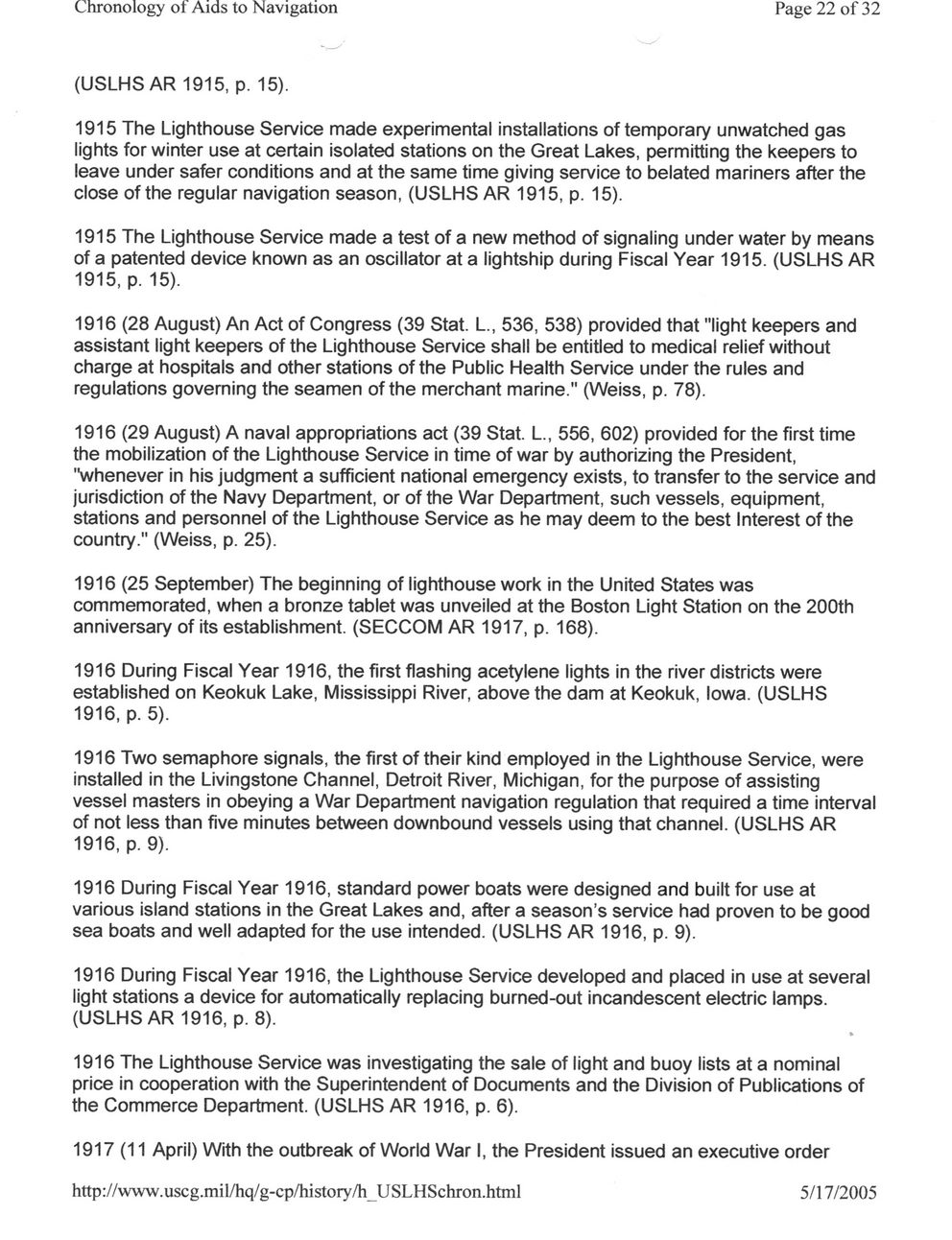This text was obtained via automated optical character recognition.
It has not been edited and may therefore contain several errors.
Chronology of Aids to Navigation Page 22 of 32 (USLHS AR 1915, p. 15). 1915 The Lighthouse Service made experimental installations of temporary unwatched gas lights for winter use at certain isolated stations on the Great Lakes, permitting the keepers to leave under safer conditions and at the same time giving service to belated mariners after the close of the regular navigation season, (USLHS AR 1915, p. 15). 1915 The Lighthouse Service made a test of a new method of signaling under water by means of a patented device known as an oscillator at a lightship during Fiscal Year 1915. (USLHS AR 1915, p. 15). 1916 (28 August) An Act of Congress (39 Stat. L., 536, 538) provided that "light keepers and assistant light keepers of the Lighthouse Service shall be entitled to medical relief without charge at hospitals and other stations of the Public Health Service under the rules and regulations governing the seamen of the merchant marine." (Weiss, p. 78). 1916 (29 August) A naval appropriations act (39 Stat. L., 556, 602) provided for the first time the mobilization of the Lighthouse Service in time of war by authorizing the President, "whenever in his judgment a sufficient national emergency exists, to transfer to the service and jurisdiction of the Navy Department, or of the War Department, such vessels, equipment, stations and personnel of the Lighthouse Service as he may deem to the best Interest of the country." (Weiss, p. 25). 1916 (25 September) The beginning of lighthouse work in the United States was commemorated, when a bronze tablet was unveiled at the Boston Light Station on the 200th anniversary of its establishment. (SECCOM AR 1917, p. 168). 1916 During Fiscal Year 1916, the first flashing acetylene lights in the river districts were established on Keokuk Lake, Mississippi River, above the dam at Keokuk, Iowa. (USLHS 1916, p. 5). 1916 Two semaphore signals, the first of their kind employed in the Lighthouse Service, were installed in the Livingstone Channel, Detroit River, Michigan, for the purpose of assisting vessel masters in obeying a War Department navigation regulation that required a time interval of not less than five minutes between downbound vessels using that channel. (USLHS AR 1916, p. 9). 1916 During Fiscal Year 1916, standard power boats were designed and built for use at various island stations in the Great Lakes and, after a season’s service had proven to be good sea boats and well adapted for the use intended. (USLHS AR 1916, p. 9). 1916 During Fiscal Year 1916, the Lighthouse Service developed and placed in use at several light stations a device for automatically replacing burned-out incandescent electric lamps. (USLHS AR 1916, p. 8). » 1916 The Lighthouse Service was investigating the sale of light and buoy lists at a nominal price in cooperation with the Superintendent of Documents and the Division of Publications of the Commerce Department. (USLHS AR 1916, p. 6). 1917 (11 April) With the outbreak of World War I, the President issued an executive order http://www.uscg.mil/hq/g-cp/history/h_USLHSchron.html 5/17/2005

Lighthouses Chronology-of-Aids-to-Navigation-(22)